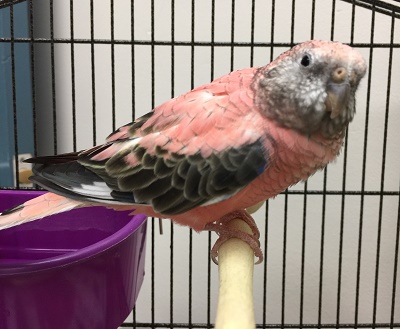
It’s the last day of September and our Animal of the Month – the Bourke’s parakeet – is flying out of the spotlight. We hope you were following us on Twitter @ExoticPetVets as we tweeted all month about these laid-back birds, whose voice can also be described as a twitter. If you missed any of our tweets, you can find a summary right here for your reference. Did you know?:
- The Bourke’s parakeet (Neopsephotus bourkii) is endemic to Australia and is found across much of the southern-central interior of the country.
- In the wild, the Bourke’s parakeet can mostly be found in arid and semi-arid grasslands and scrublands that have mulga and acacia trees. They can also be found in woodlands with eucalyptus and cypress trees – and sometimes in urban areas too.
- Because they tend to live in inhospitable areas, there is mystery and contradiction surrounding Bourke’s parakeets because of the challenges in observing their movements in the wild.
- Bourke’s parakeets are considered to be a nomadic bird species in the wild, although it’s also believed that they are capable of settling down in one area.
- It was also once thought that Bourke’s parakeets were endangered, but the IUCN Red List of Threatened Species lists the Bourke’s parakeet as a species of least concern with wild populations believed to be increasing.
- Bourke’s parakeets are also known by many other common names; such as, Bourke’s parrot, pink-bellied parrot, blue-vented parrot and sundown parrot.
- The Bourke’s parakeet was discovered by Sir Thomas Livingstone Mitchell in the Australian state of New South Wales circa 1835.
- It is widely reported that Sir Thomas Mitchell named the Bourke’s parakeet after Sir Richard Bourke, who was the New South Wales governor at the time.
- But according to “The Eponym Dictionary of Birds,” the Bourke’s parakeet may have been named after Fort Bourke because the bird was spotted near there.
- “The Eponym Dictionary of Birds” suggests the Bourke’s parakeet may have been named indirectly after Sir Richard Bourke since Fort Bourke was named after him.
- The scientific name of the Bourke’s parakeet changed in the 1990’s. Initially, they were classified under the genus Neophema (Neophema bourkii), which is made up entirely of grass parakeets.
- But when it was discovered that Bourke’s parakeets don’t appear to interbreed (hybridize) with other species in the Neophema genus, they were given their very own genus and reclassified as Neopsephotus bourkii.
- The Bourke’s parakeet is a small parrot, with adult body length measuring 20 cms (7.8 inches) on average, with their tail being about half that length.
- Wild Bourke’s parakeets are mostly a brownish-grey colour, with pink chests and bellies. They have blue feathers in the bend of their wings, under the tail and on their flanks and the side of the rump.
- The area around the Bourke’s parakeets’ eyes are white, which some observers say make it look like they’re wearing glasses.
- The Bourke’s parakeet is a sexually dimorphic species, meaning there are obvious physical differences between the females and males.
- Male Bourke’s parakeets have a band of blue feathers on their foreheads – something their female counterparts lack. The feather colour on the females is also duller and they have smaller heads and beaks.
- In captivity, selective breeding of Bourke’s parakeets has created several different colour morphs – including rosy, fallow, lutino and cinnamon.
- Bourke’s parakeets are good-natured and mellow birds. They are intelligent, but are not known for mimicking human speech or doing tricks like many other parrot species.
- Bourke’s parakeets are also very quiet compared to many other bird species, which is appreciated by people who don’t like noise or live in apartments.
- With their unforgiving natural habitat of Australia’s arid interior, Bourke’s parakeets cope with the searing daytime heat by relaxing in the shade of the trees.
- Bourke’s parakeets may be a parrot species, but they have some night owl tendencies – even though they are not considered to be nocturnal as are most owls.
- Bourke’s parakeets are active at dawn and dusk when they forage for grass and seeds and gather at watering holes. But they are not considered to be truly crepuscular.
- Bourke’s parakeets are actually semi-nocturnal because they are most active between sunset and the total darkness of nightfall, which is an unusual characteristic among parrot species.
- With proper care, Bourke’s parakeets can live between 9-12 years in captivity.

